All about lean-to sheds
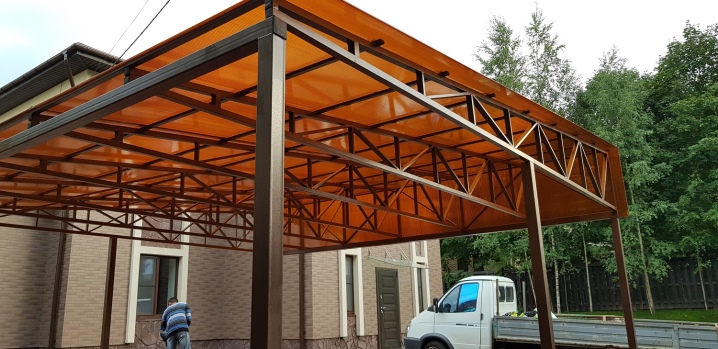
The shed canopy has a lot of advantages, including speed and ease of assembly. It is easy to make such a design yourself if you follow the manual and a well-drawn drawing. In the latter, it is important that everything is correctly measured and calculated, otherwise the canopy will not withstand the necessary loads.
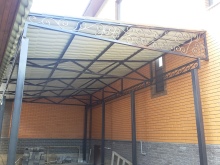
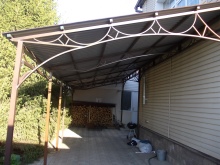
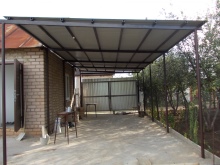
Peculiarities
Shed sheds are very simple, which makes them quite popular. The uncomplicated design is easy to assemble by yourself. Usually, the canopy consists of support posts, trusses, lathing and roofing. It is worth noting that even completely ready-made kits are presented in building stores, which are very quickly assembled with their own hands. However, drawing up independent drawings and carrying out the necessary calculations is also a simple process.
In the course of creating a canopy, its slope should be taken into account. This parameter is important. It should be determined based on the climate where the construction will take place.

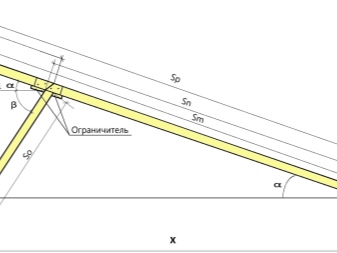
For example, in areas with heavy snowfall, the slope should be at least 35 degrees. This allows the slope to remain intact, even if there is a lot of snow on it.
For places where winds with strong gusts are frequent, gently sloping canopies with a slope not exceeding 25 degrees are recommended. In most areas in Europe, a 30 degree slope design is sufficient.
For the rafter system, it is important to choose the right material so that it will last for many years. For example, a metal structure will become lighter and more durable. If you want to make rafters out of wood, then you will have to treat them with special antiseptics, and apply a layer of paint on top.
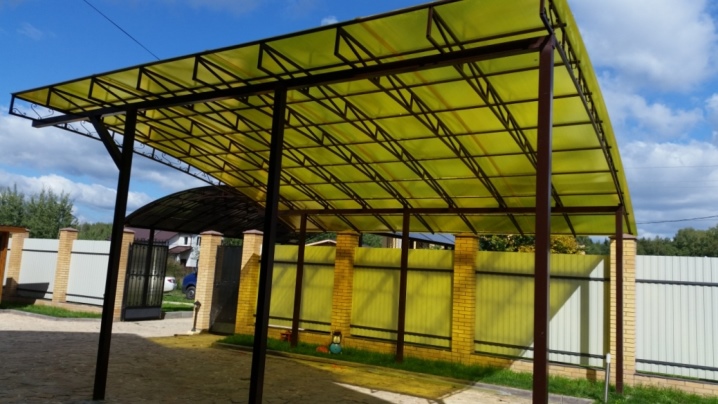
Varieties
There are a large number of varieties of lean-to sheds. They are divided in many ways.
You should familiarize yourself with each of the types in order to better understand which canopy is suitable in a particular case: straight or arched, adjacent or free-standing, and so on.
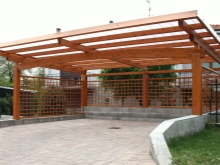
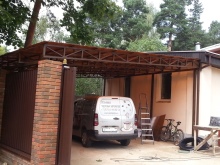
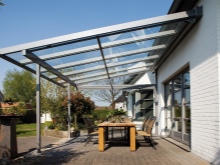
So, according to the method of construction, several options for canopies are distinguished.
-
Installed separately, it is located close to the main objects. Often, such a canopy serves as a gazebo or is suitable for storing various equipment.
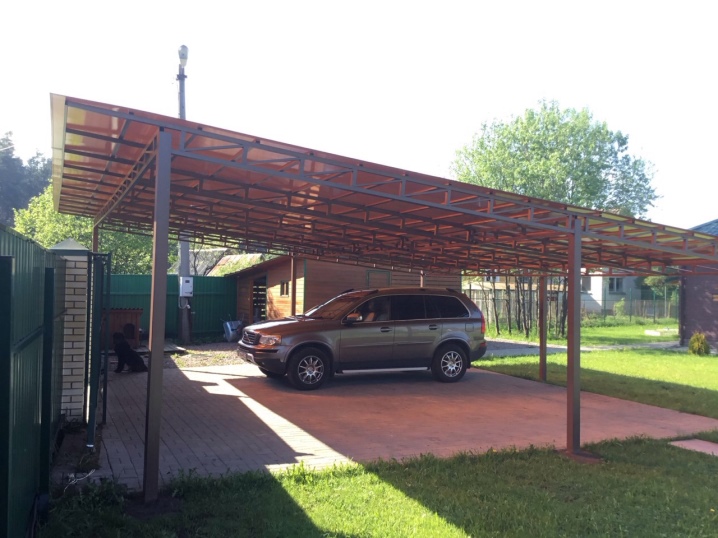
- Adjacent to the house (support-cantilever) is directly adjacent to the building and is a useful addition. Usually, a canopy is a protection from precipitation, sunlight and other unpleasant influences. Most often it is collected above the entrance, or it is adjacent to any wall of the building. This type can be built both at the stage of building an object, and attached to an already finished one.
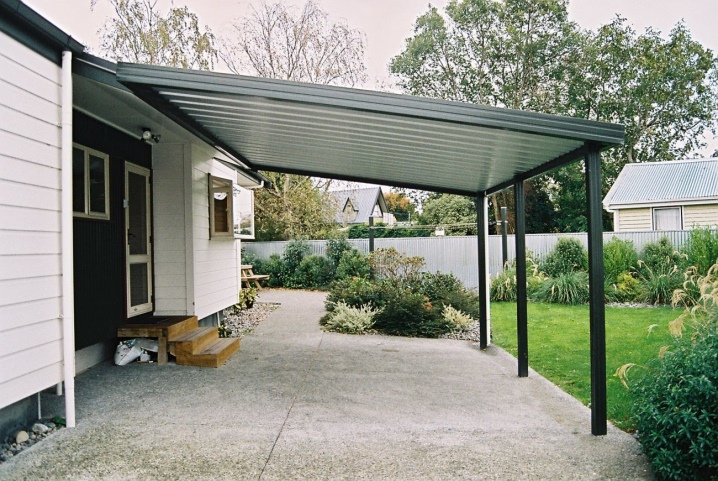
It should be borne in mind that awnings differ depending on their functionality.
-
The decorative option is suitable as an addition to the already finished composition of buildings and the adjacent landscape.
-
Protective makes it possible to hide from precipitation, ultraviolet radiation from the sun's rays. It prevents the walls of objects from collapsing and makes their service life much longer.
-
Decorative and protective can be combined in one canopy. But this must be done even at the stage when the drawings are being prepared.
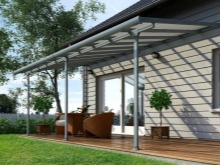
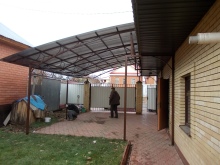
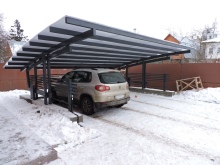
And also hinged structures can differ in the type of fasteners to the structure.
-
The suspended view is fixed to the wall using special suspension elements.
-
Supported or wall mounted vertically or wall mounted. The size of this type of canopy can be very different.For their manufacture, you can use any material you like, including metal.
-
The suspended version is small in size. It is usually made from the lightest materials in order to avoid heavy loads on the base of the structure.
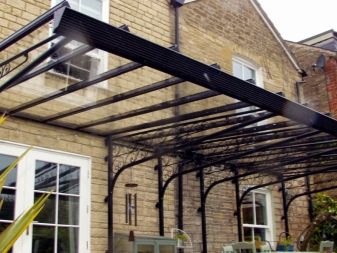
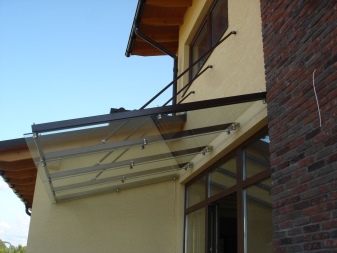
Shed roof sheds can also differ in how they will be used.
-
The design for the temporary stay of people implies something light, maybe not very strong. In fact, this is a replacement for gazebos or a veranda. In this case, the canopy can be made open, half-open, closed. And also it is suitable as an extension to the house.

- The option for storing cars and other equipment is suitable for temporarily placing cars of any size under it. At the same time, the equipment is well protected from winds, rain, hail and snowfall. The option is profitable from an economic point of view and is distinguished by the speed of construction. For this purpose, a canopy can be made from both metal and wood. The main thing is that it turns out to be quite durable.
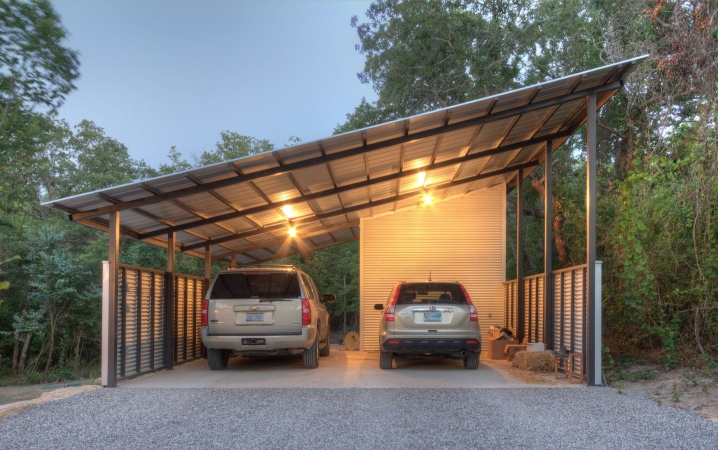
Materials (edit)
Before proceeding to drawing up drawings of a canopy with a lean-to roof, you should decide what material the frame and the roof itself will be made of.
When creating with your own hands, you should take into account how reliable and functional material will be used. And also a tangible moment when choosing is the cost of materials.
It is equally important to take into account the size of the canopy, its mounting, weight and rules for working with this or that material. Of course, first of all, everything depends on personal wishes. For example, you can build a canopy on piles or from a soft roof.
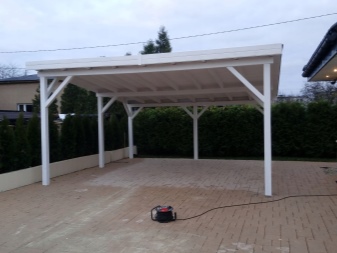
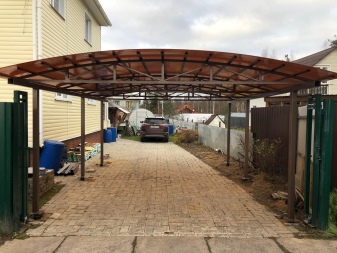
Frame
For the frame of the structure, there are three types of materials.
-
The metal is a galvanized cold-rolled pipe or steel profile with increased rigidity. In this case, the frame can be standard, complex or forged. This type is distinguished by a long service life, high quality, and also withstands the influence of natural factors.

- The tree can be represented by various types of wood. Supports can be made of timber or logs, but only rounded. As for the strapping and lathing, then slats, lining, edged board are suitable for them. The main thing is to process the material with an antiseptic before use, and then a layer of paint. This will prevent rotting and also reduce UV exposure from the sun's rays.

-
The mixed version combines elements of metal and wood. As a rule, pipes or profiles with high rigidity are selected for the support system, and wood for the roof and battens.
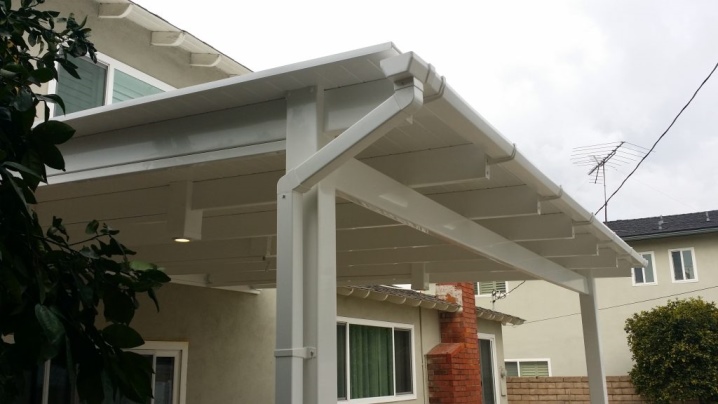
Another type of frame is very rare - stone. Of course, this option is time consuming, but at the same time it is more durable. This design will last 2-3 times longer than other types.

Roofs
Currently, among the roofing materials suitable for shed awnings, several options stand out.
-
Corrugated board known among other materials for its low weight, long service life, increased strength. And it is also good in that precipitation does not have a mechanical effect on it. It is very convenient that the sheets of corrugated board have a guarantee for an impressive period.
It is not difficult to choose a color from the proposed range, since it is distinguished by its variety. Moreover, you can safely buy bright colors, because they will not fade in the sun. Of course, it is important to correctly mount this material so that during heavy precipitation nothing penetrates into the building. Self-assembly will not be difficult at all. With all its advantages, corrugated board is also distinguished by its low cost.
The disadvantages include insufficient sound insulation. And also the material is not very resistant to mechanical damage. Because of this, there is a high risk of corrosion.
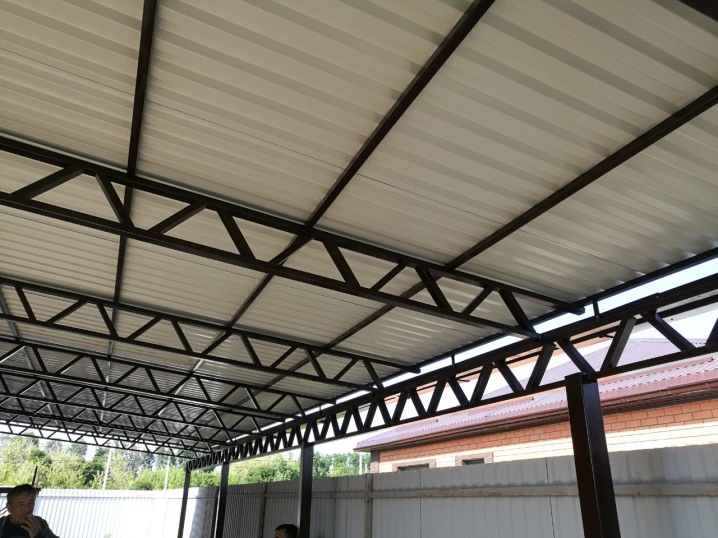
-
Polycarbonate Is a polymer plastic that looks like glass.The structure of this material can be represented in the form of honeycombs and cells. Among the many qualities of polycarbonate sheets, one should highlight increased strength, resistance to corrosion and deformation. It is worth noting that panels of a certain color are capable of absorbing ultraviolet light from the sun's rays, while not interfering with normal illumination.
Another plus is that polycarbonate is lightweight. Many people like its low thermal conductivity, environmental friendliness, good sound insulation, resistance to temperature fluctuations. In addition, it is easy to maintain a canopy made of this material. A variety of colors and shades of polycarbonate sheets will not leave anyone indifferent, as well as reasonable prices for it.
However, it is necessary to take into account some of the disadvantages of such a roof - a certain thermal gap during installation, transparency, low resistance to abrasive damage, as well as too strong reflectivity.
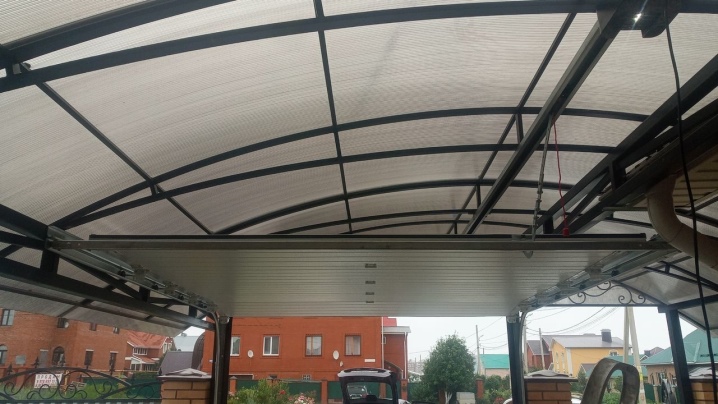
-
Metal tile represented by steel, copper and aluminum sheets, on which a protective layer of polymers is applied. The durable material is lightweight and convenient because it is easy to install and, if necessary, to repair. Metal roofing is considered environmentally friendly. In this case, you can choose the most suitable color from a wide palette.
You can cope with the installation of this material yourself, having received some skills, or use the help of specialists. In the latter case, the costs will not be too high. It is convenient that metal roofing can be made even at low temperatures.
The downside of this material is poor sound insulation. When using metal tiles, you will have to purchase special tools in advance. It should also be noted that damage to the coating in several places can cause corrosion.
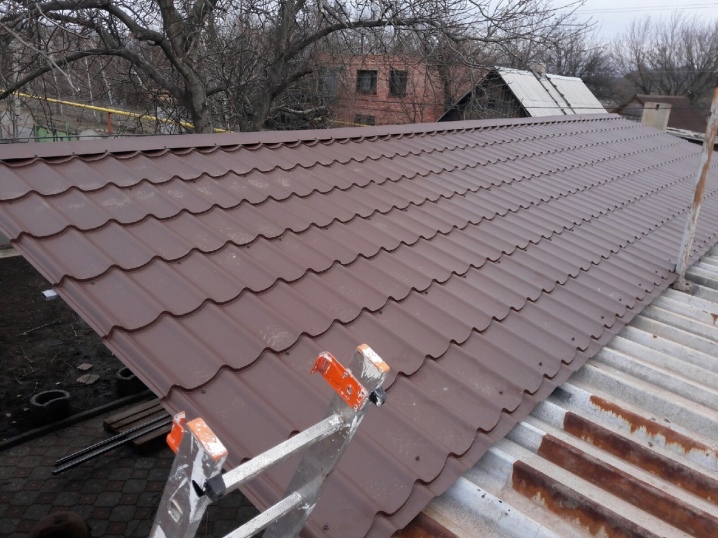
Construction stages
It is not difficult to make a canopy with a pitched roof with your own hands, if you familiarize yourself with all the nuances in advance. It is very important to create the correct drawing and select the optimal materials. It is advisable to act according to certain stages of construction.
At the first stage, it is planned to develop a drawing according to which the structure will be erected. To do this, you need to determine the size of the future canopy.
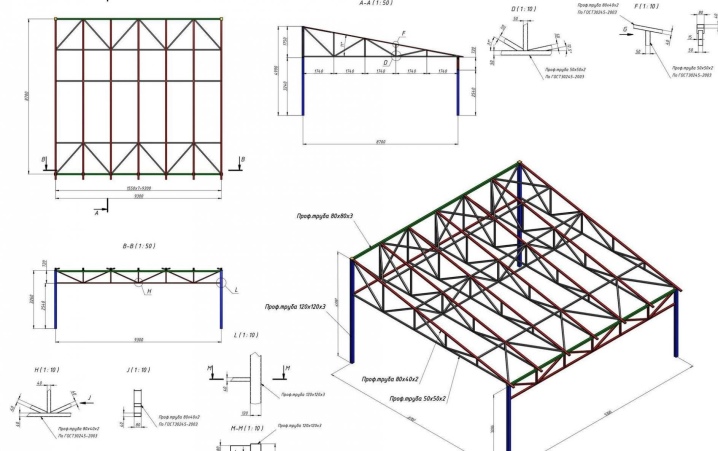
For example, it can be large 5 by 6 or compact 4 by 3 meters. The optimal size is 4x6 m. Next, it is important to calculate the loads on the supports.
Now you can calculate how much and what materials you need, choose the angle of inclination. When calculating materials, you can use a special program. It will also help with calculating the number of supporting structures and nodes. After that, you can proceed to the purchase of the necessary materials and tools.
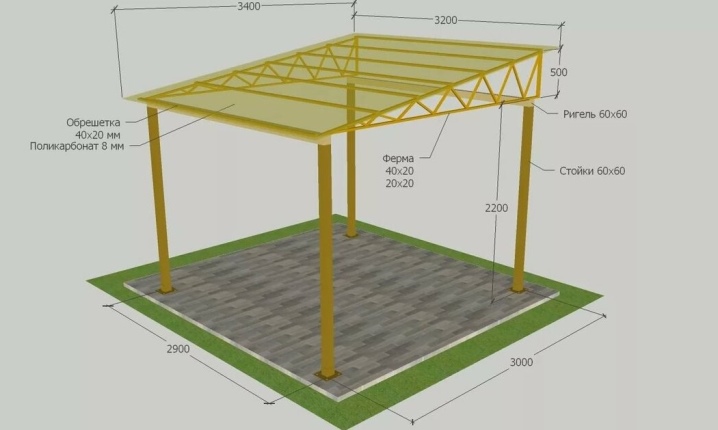
It is worth clarifying that, when a diagram is created, the drainage system should be thought out as best as possible. After all, a lean-to canopy assumes that precipitation will flow in only one direction. For heavy loads, it is important to provide trusses, which are a metal frame. The latter has features in the form of belts at the top and bottom, which are welded and form vertical posts and braces.
When building a canopy from a pipe, they should be selected so that the length of the upper pipe is longer than the lower one.
This is necessary so that the visor has a slope. Trusses are best placed at the edges of the roof or in the middle. In this case, the spacers are welded in a zigzag manner to the lower and upper pipes.
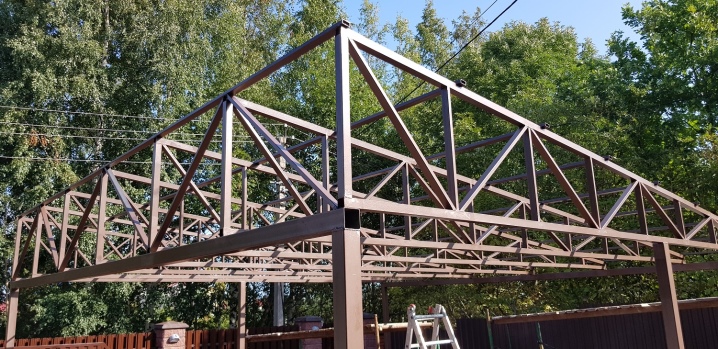
The next step is preparatory work on the site where the canopy project will be implemented. It is necessary to apply markings on it according to the drawing. Then the support structures can be built.
You can now build the support structures. For this, pits 80 cm deep are dug. A 5-centimeter concrete solution is poured onto the bottom of the pits, into which pipes must be placed. Outside, they also need to be fixed with a solution.
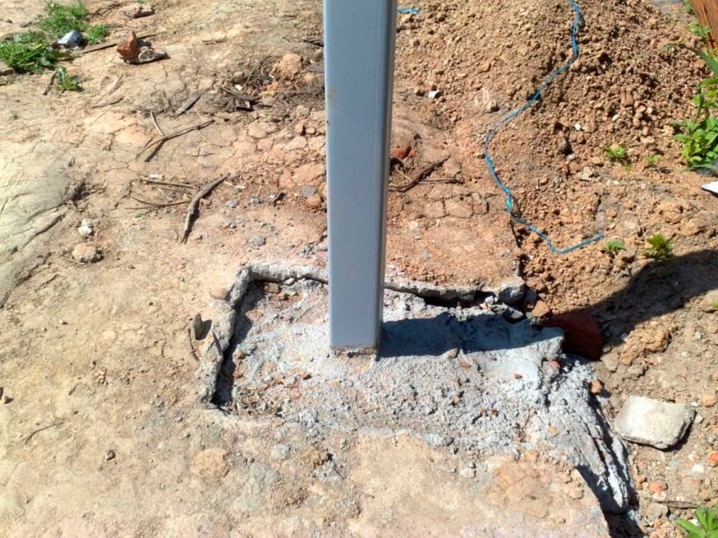
After that, the pipes must be leveled, supported with boards and left to harden for three days. Boards using self-tapping screws are mounted with a protrusion over the edge of the post by 3 centimeters. The final fastening is done with spacers cut at an angle of 45 degrees and self-tapping screws. Then you can fix the trusses, and the roof on them. Depending on the material chosen, ordinary self-tapping screws or with thermal washers are used for this.
The final stage is the installation of a drain. This will prevent water from accumulating next to the built canopy.
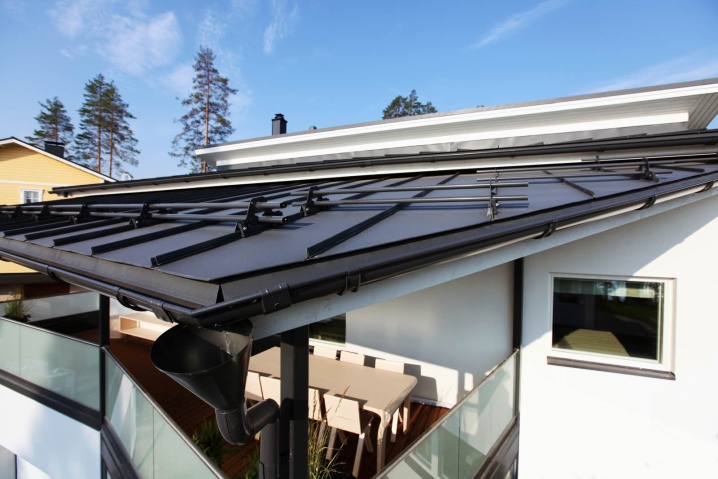
For an overview of the shed canopy from the profile, see below.





























































The comment was sent successfully.